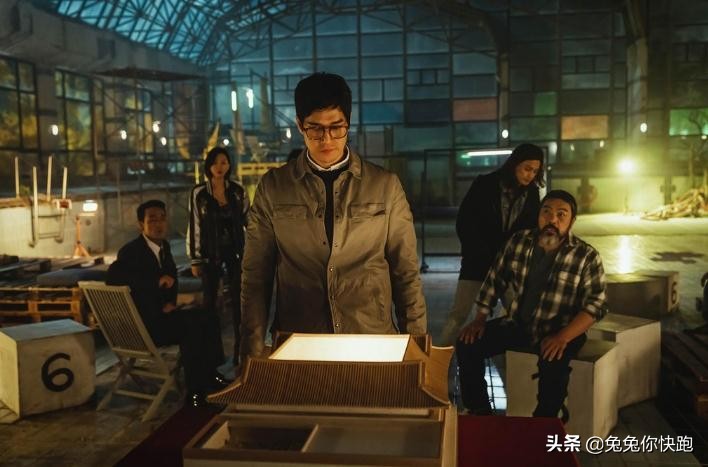The Korean version of "Paperhouse" melts the divisive reality and increases the tension to change the character
Background of the former Korean Peninsula Common Economic Zone for reunification... The story structure is faithful to the original
Elements with Korean overtones, such as the Bulletproof Youth Regiment, the Ha Hui Mask, and Yu Guangshan's Portrait Coin, are also eye-catching.
A group of robbers wearing red jumpsuits and white hahoe masks attacked the mints in the North-South Joint Economic Zone. In order to buy time to print 4 trillion won worth of currency and act as hostages, the bandits who have made careful plans have unexpected emergencies one by one.
The Netflix original series "Paperhouse: Common Economic Zone", which will be released on the 24th, is based on the Spanish Netflix eponymous series that ended season 5 at the end of last year. This TV series that has attracted the world's attention with the rebirth of "K-content" as a global blockbuster adds the reality of South Korea as a divided country in the original work.
The South Korean version of "Paper house" begins with a girl (Jeon Jong-seo) in Pyongyang, North Korea, dancing in a dancing pose with a BTS song. A young girl comes to South Korea with a Korean dream on the Korean Peninsula, where North and its residents can come and go freely before reunification. Frustrated by the reality of the office of human resources, however, he became a thief with gun handling skills he learned in North Korea. The person who came into contact with such a girl was a man (Liu Zhitai) who called himself a "professor" by robbing the mint together.
The professor is a gifted strategist who orchestrates this daring crime, and he gathers a group of bandits of varying abilities. Under his leadership, robbers hid their identities from each other, nicknamed cities around the world, and engaged in unprecedented criminal activities.
The robbers include Berlin (Park Hae-so), who escaped from North Korea's Kaecheon concentration camp, Moscow (Lee Won-jong), South Korea's first underground bank robber, and Denver (Kim Ji-hoon), a street fighter. Moscow, Nairobi (Jang Yoon-joo), crooks and various counterfeiters, and Liu, a genius hacker. Helsinki (Kim Ji-hoon) and Oslo (Lee Kyu-ho), the solver of the organization work in Yanbian (Lee Hyun-woo), together. A girl who is dancing a bulletproof youth group participates in a robbery in the name of Tokyo.
The overall story structure is not much different from the original book. If you only look at the major events, it feels as if the original has been faithfully transferred. A professor who controls the situation outside the mint so that the plan is not frustrated, a hostage shot by the police for accidental action, and a split inside the robbery, the main setting and plot follow the elaborate original.
The professor's belief that "no one should die" made the Century Robbers look like good people, even when they threatened hostages with guns. This is also the reason why the atmosphere of "Paperhouse" is very different from that of existing crime films.
And, contrary to the professor's elaborate plans, the members of the robbers did not seem to be skilled at all. Each of them is highly capable, but in the face of unexpected situations, they hesitate and even fight the deception of the hostages.
The appearance of these robbers has left them anxiously waiting for them to break through tight security checks, occupy the mint, control 60 hostages, and whether the real purpose of printing money will be revealed by the police.
However, the crimes of the robbers who took over the mint were not loosely portrayed. An unplanned police-to-police shooting scene and a Berlin fugitive who ignores the professor's beliefs and tries to execute the hostages create a harsh atmosphere.
The Korean version also has a unique observation point. The divided state situation has created confrontation between hostages from North and South Korea and has exacerbated tensions by including factors of mistrust and checks and balances in the inter-Korean joint response team that negotiated with the robbers.
The characters are also slightly different from the original. The most iconic figure is Tokyo, which in the original version is known for its freedom and unrestrainedness, but in the Korean version it is portrayed as a North Korean immigrant who has experienced the bitter taste of capitalist society and a careful man who thinks "rightly". Judgment as a person". In the original, Liu is the son of an ordinary family, but in the Korean version, he has the story of a rich son who is forced to become a doctor.
In addition, Korean materials and props such as the bulletproof boy band song in the first act of the play, the Ha Hui mask that replaced the original Salvador Dali mask, and the portraits of martyrs Yoo Guanshan and Dr. Ahn Jung-geun were painted on the common currency of South Korea and North Korea, and the roof of the mint's traditional Hanok was very conspicuous. Turn it off
